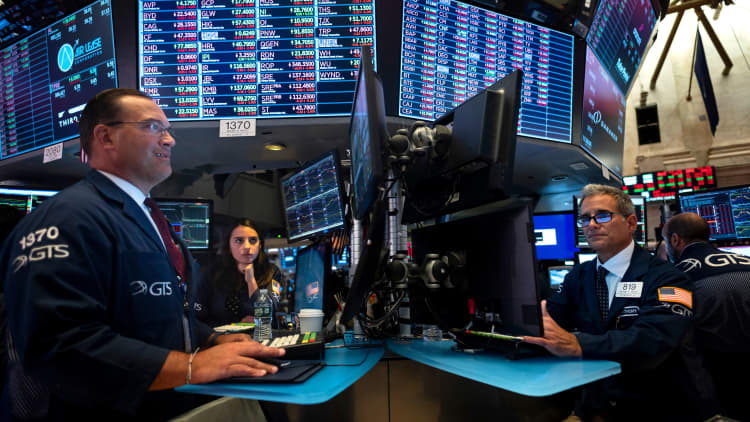
Investors clamored into the safety of U.S. government bonds, sending the 30-year Treasury bond yield below 2% for the first time ever and the 10-year Treasury note yield below 1.5%, a three-year low.
Around 2:00 p.m. ET, the yield on the benchmark 10-year Treasury note, which moves inversely to price, hit a three-year low of 1.475%, while the yield on the 30-year Treasury bond was at 1.944%, after earlier falling to 1.941% for the first time ever. The 2-year Treasury yield was 1.467%, its lowest level since Oct. 2017.
The historic drop in long-term U.S. bond yields comes shortly after interest rates on the closely watched 10-year and 2-year Treasurys inverted. The inversion of this key part of the yield curve has previously been a reliable indicator of economic recessions.
"The yield curve inverted which created a temporary 'pile on' effect in the bond markets," wrote Tom Essaye of The Sevens Report. "We have absolutely not seen what we wanted to out of the Fed. We had hoped for a rally in the 10-year yield and a widening of the 10s-2s spread. The exact opposite has occurred, and at this point currency and bond markets are no longer flashing 'caution' signs on the U.S.-global economy and risk assets, they are flashing a 'warning' sign —loudly."
That part of the curve was positively sloping again on Thursday but only slightly.
"The 30-year yield in itself is historic given that it is moving to massive lows but the curve inversion is typically the signal, one of the better signals you can get, that there is increased risk of recession," said Bank of America technical strategist Stephen Suttmeier.
Treasurys
The stock market took a huge hit in the previous session, with the Dow plunging 800 points in its worst decline of the year and fourth-largest point drop ever to a two-month low. The sell-off exacerbated an extensive flight-to-safety into government securities.
Stocks on Thursday reversed lower as bond yields fell to new lows.
However, markets rose on Friday after Hua Chunying, a spokesperson at China's Ministry of Foreign Affairs, said China "hopes the U.S. will meet China halfway and implement the consensus reached by the two leaders during their meeting in Osaka." This trade headline took pressure off bonds as the 10-year yield rose above the 2-year yield.
This is after China said Thursday it has to take necessary countermeasures to the latest U.S. tariffs on $300 billion of Chinese goods. The ministry also said the U.S. tariffs violate a consensus reached by leaders of two countries and get off the right track of resolving disputes via negotiation.
At times of market turbulence, investors tend to flee to assets expected to either retain or increase in value — such as gold, the Japanese yen and government bonds. These safe-haven assets are typically sought to limit one's exposure to losses in the event of a sharp market downturn.
Following a yield curve inversion, its common that markets would top out before they start to enter a period of downturn months later. Suttmeier said the seasonality matches the cyclical data in this case.
"The seasonality and the inversion signals are aligned here. Meaning that, you get a dip after inversion into October, November and then a rally, we could be set up for a rally based on the inversion signals from November into January," he said.
Recession fears
It comes at a time when market participants are worried about a protracted U.S.-China trade war, geopolitical tensions and uncertainty over Brexit. Economic data in China and Germany this week also suggested a faltering global economy.
Around the time of the mover lower in yields, the Mexican central bank cut its benchmark rate, citing the yield curve as a factor.
However, strong economic data helped lift stocks. Retail sales rose solidly in July and beat expectations, which is a sign of consumer optimism. The U.S. productivity also grew a healthy 2.3% rate in the second quarter.
The number of Americans filing applications for unemployment benefits increased more than expected last week, but the trend continued to point to a strong labor market.
Initial claims for state unemployment benefits rose 9,000 to a seasonally adjusted 220,000 for the week ended Aug. 10, the Labor Department said on Thursday.
The U.S. Treasury is set to auction $55 billion in 4-week bills and $40 billion in 8-week bills on Thursday.



